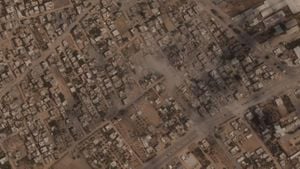Heightened tensions between Israel and Lebanon have become the backdrop for one of the most significant and complex military confrontations of recent years. Following nearly thirteen months of intermittent conflict, which intensified after the Hamas attack on Israel on October 7, 2023, Israel has launched extensive military operations against Hezbollah and its infrastructure across Lebanon. This latest escalation has prompted discussions on the nature of warfare today, particularly with the introduction of modern military technologies on both sides.
The Israel Defense Forces (IDF) conducted significant airstrikes throughout Lebanon, with over thousands confirmed since the escalation began. The strikes have reportedly focused on Hezbollah targets, military infrastructure, and weapon stockpiles. This intensified military campaign aims at degrading Hezbollah's operational capabilities, which have become increasingly sophisticated and well-equipped. Remarkably, classroom-influenced narratives about the past, such as the significant roles of Soviet-supplied Soviet-built missiles during the October 1973 war, are juxtaposed against modern realities where Israeli air force operations have seen no losses from sophisticated Iranian-made air defense systems.
Air superiority remains firmly with the Israel Air Force (IAF). Israeli F-16s and the stealth F-35 fighters have operated with impunity, successfully executing airstrikes targeting Iranian military bases and missile factories without downing any aircraft. This raises substantial questions about the efficacy of Russian-made surface-to-air missiles like the S-300 and S-400 when faced with advanced American technology. It appears the age-old adage—what goes up must come down—may see new interpretations as combatants adapt rapidly to technology-driven warfare.
During the last decade, Hezbollah has strategically evolved from its origins as a guerrilla force to become one of the most formidable military actors facing Israel. With the extensive use of drones, particularly so-called "suicide drones" or loitering munitions, both sides have entered what many refer to as the 'drone age of warfare.' These drones have not only been used for reconnaissance but also as precision strike tools to launch attacks against both military and civilian targets, raising the stakes and complicity of ethical warfare.
Reports indicate Iran has supplied Hezbollah with several models of drones, including the Shahed 136, which has gained notoriety since it was employed extensively during the Israel-Hamas conflict. These drones carry explosive payloads and can be officially directed by operatives or autonomously target objective positions. The last waves of conflict, characterized by both sides deploying drone swarms, have seen heightened public fear among Israelis as they navigate life under unpredictable aerial threats. Instances of drones penetrating air defenses have left civilian areas vulnerable even to sporadic strikes. Israel is reportedly investigating developing new technologies—like ground-based laser systems—to counter these threats at lower operational costs, signaling the burgeoning arms race on both fronts.
While attention to drone warfare proliferated, ground combat has not diminished, particularly as Israeli forces have commenced ground operations under the pretense of restoring peace to northern communities near their borders. The "Northern Arrows" operation, reportedly aimed at targeting LAF (Lebanese Armed Forces) and militia bases bordering Israeli territory, raises questions about Israel's long-term strategy. Observers believe the limited military objectives set out by the IDF may be politically motivated—striking to appease domestic voices on security without incurring extensive casualty risks or inviting American scrutiny on expanded military engagement.
Humanitarian issues continue to surge as civilian infrastructure has been all but destroyed, with accusations of collateral damage surfacing around the bombing near historic sites, such as the ancient Roman temples at Baalbek—the elegance of ancient architecture caught between the hammer of modern warfare and rich cultural heritage. Concerned archaeologists have brought awareness to the precarious nature of these UNESCO world heritage sites, questioning the IDF's claims of targeting only military structures. The tension has prompted local archaeologists to rally against perceived disregard for cultural preservation amid combat missions.
Throughout the conflict, Hezbollah maintains strategic resilience and has enacted defenses, positioning advanced missile systems such as the Kornet anti-tank guided missiles within their arsenal. These weapon systems have proven effective against Israeli ground forces, particularly their armored tanks, requiring the IDF to adapt its tactics continually. Enhanced versions of these weapons double the output of destruction compared to their predecessors. This juxtaposition of advanced military technology has contributed to increased casualties on both sides—prompting awareness of the grave human cost associated with unending military exchanges.
With the return of limited skirmishes as hostilities between Israel and Hezbollah escalate, it’s apparent to analysts and military observers alike—to maintain strategic dominance, Israel faces the continuously shifting landscapes of drone warfare, urban combat, and the historical cost of military projections on civilian contexts. The conundrum remains: How can leaders navigate these challenges without spiraling conflicts fostering worlds of devastation, culture destruction, and untold human tragedies?”



